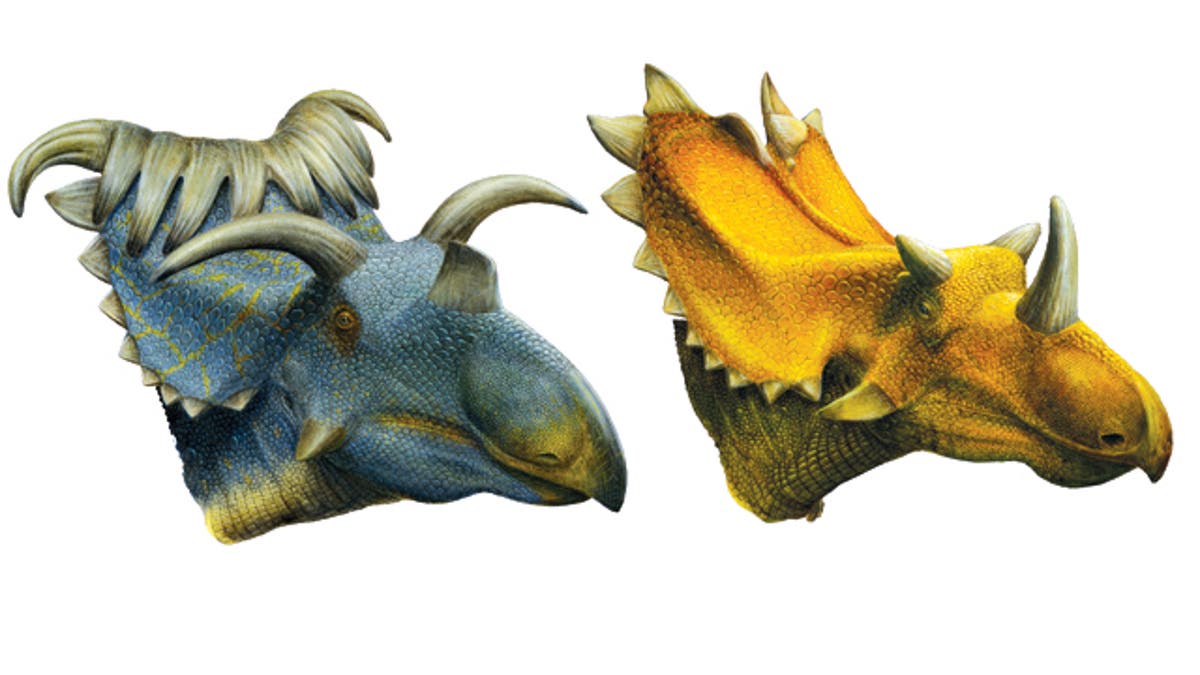
A bizarre dinosaur with 15 horns (at left) is one of two new close relatives of Triceratops that scientists unearthed in southern Utah from lands once part of a now-lost continent. (Utah Museum of Natural History/Lukas Panzarin)
On a "Lost Continent" that once covered much of the land now occupied by the U.S., paleontologists have discovered fossils of two new dinosaur species, relatives of the famed Triceratops.
The new Kosmoceratops has five times as many horns on its head as its cousin, making it the most ornately adorned dinosaur known to man. It and the larger-bodied, five-horned Utahceratops were giant plant-eaters that lived in "Laramidia" -- a continent formed when a shallow sea flooded the central region of North America, isolating the eastern and western portions of the continent for millions of years during the Late Cretaceous Period.
The newly discovered dinosaurs, close relatives of the famous Triceratops, were announced today in PLoS ONE, the online open-access journal produced by the Public Library of Science.
Utah scientists believe most of the horns were used to attract mates and intimidate rivals of the same species. The dinosaur fossils were found in the Grand Staircase-Escalante National Monument in Utah -- a hotbed for dinosaur discoveries over the past decade -- and skulls of the species are on display at the Utah Museum of Natural History.
The bigger of the two new dinosaurs, with a skull 2.3 meters (about 7 feet) long, is Utahceratops gettyi (U-tah-SARA-tops get-EE-i). The first part of the name combines the state of origin with ceratops, Greek for "horned face." The second part of the name honors Mike Getty, paleontology collections manager at the Utah Museum of Natural History and the discoverer of this animal.
Mark Loewen, one of the authors on the paper, likened Utahceratops to "a giant rhino with a ridiculously supersized head."
Kosmoceratops richardsoni (KOZ-mo-SARA-tops RICH-ard-SON-i) is named for Scott Richardson, the volunteer who discovered two skulls of this animal. Kosmoceratops also has sideways-oriented eye horns, although much longer and more pointed than in Utahceratops.
In all, Kosmoceratops possesses a total of 15 horns -- one over the nose, one atop each eye, one at the tip of each cheek bone, and ten across the rear margin of the bony frill -- making it the most ornate-headed dinosaur known.
Scott Sampson, the paper's lead author, claimed that, "Kosmoceratops is one of the most amazing animals known, with a huge skull decorated with an assortment of bony bells and whistles."
For most of the Late Cretaceous period, tens of millions of years ago, exceptionally high sea levels flooded the low-lying portions of several continents around the world. In North America, a warm, shallow sea called the Western Interior Seaway extended from the Arctic Ocean to the Gulf of Mexico, subdividing the continent into eastern and western landmasses, known as Appalachia and Laramidia.
Whereas little is known of the plants and animals that lived on Appalachia, the rocks of Laramidia exposed in the Western Interior of North America have generated a plethora of dinosaur remains. Laramidia was less than one-third the size of present day North America, approximating the area of Australia.
Clearly many more dinosaurs remain to be unearthed in southern Utah, the archaeologists said.
"It's an exciting time to be a paleontologist," Sampson added. "With many new dinosaurs still discovered each year, we can be quite certain that plenty of surprises still await us out there."
FoxNews.com's SciTech section is on Twitter! Follow us @fxnscitech.




















